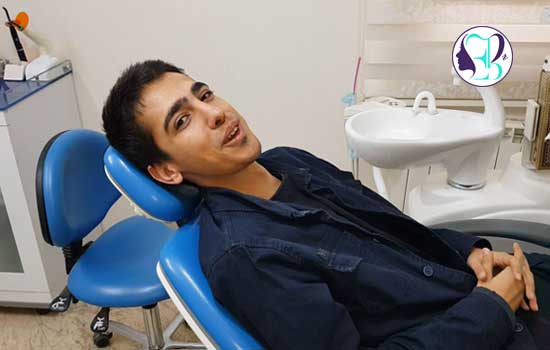Moving and pulling out the canine tooth hidden under the gums

Moving and pulling out the canine tooth hidden under the gums

Permanence of permanent teeth
Stinging of the canine means that the canine is stuck under the gums and cannot come out properly, so in addition to being aesthetically pleasing, the tooth has virtually no function. Tooth occlusion usually occurs in the third mill tooth, known as the wisdom tooth.
These teeth are the last teeth to protrude from the gums and are located at the back of the mouth, so in many cases there is not enough space to extract them and these teeth become occluded or semi-occluded and cause many problems such as pain, infection and abscess. they do.
In the case of wisdom tooth occlusion, because it usually does not need to be replaced and does not need to be replaced, it can be removed with surgery if there is a problem.
But in the case of high canines, which have the largest amount of dentition after wisdom teeth, the issue is not so simple. Fangs are an important tooth in the dental arch and play an important role in eating and talking.
Fangs are very strong to chew and have the longest roots among all teeth. Fangs are the first teeth that come in contact when closing the jaws and guide the jaw and the rest of the teeth to the correct position.
What is the occlusion of a canine tooth?
Normally, maxillary canines are the last front teeth to protrude. At the age of thirteen, permanent canines usually come out and completely close the empty space in front of the mouth.
If the canine tooth gets stuck under the gums, it should be pulled out and guided in place.
There are techniques to help extract and guide the canine that can be used for all impacted upper and lower teeth.
Sixty percent of the upper incisors are located in the roof of the mouth, and the rest are stuck in the middle of the supporting bone and are in a higher position than the roots of adjacent teeth or in front of the arch (towards the face (facial)).
The importance of timely detection of canine occlusion
Older children are more likely to have their impacted teeth pulled out with the help of natural forces, even if there is enough space in the dental arch.
The American Society of Orthodontists recommends panorex X-ray screening with oral examination in all children as young as seven years old. All teeth should be counted at this examination to determine if there is a problem with the extraction of permanent teeth.
It should be noted that all permanent teeth are present in the jaw or some of them are missing.
Check for extra teeth or abnormal appendages that may block the canine protrusion. It is also found that the space of the dental arch may be so small that the canine does not have enough space to protrude.
These examinations are usually performed by a general dentist. Treatment of such problems requires orthodontic brackets to open the space needed for permanent teeth to protrude.
The oral surgeon may also need to remove extra teeth or abnormal appendages that have blocked the extraction path. If at the age of 11 to 12, the extraction path opens on the tooth and there is enough space in the dental arch, it is possible for the impacted canine tooth to come out naturally without assistance.
If the canine has grown to the age of 13 or 14 and has not yet erupted, it will not erupt on its own, even when the space is open. If the patient is very old (over 40 years old), it is very likely that the tooth is in place.
In such cases, the tooth does not move despite the efforts of the orthodontist and oral surgeon. Unfortunately, the only solution at this stage is to extract the impacted tooth and fill the gap with a type of dental prosthesis such as a bridge.
What to do if there is not enough space for the canine to come out?
In cases where the canine does not protrude spontaneously, the oral surgeon, in collaboration with the orthodontist, helps the canine to protrude and return to its original position. Each case should be considered separately and selected depending on the circumstances of the treatment, but usually requires both surgery and orthodontic brackets.
In most cases, the bracket must be attached to the upper teeth and there must be enough space for the impacted tooth to protrude. If the baby canine tooth has not yet fallen out and is still in place, it is usually held in place to allow enough space for the permanent canine tooth to protrude.
The patient is then referred to an oral surgeon to open and remove the tissues on the canine tooth during surgery to attach the bracket jewel to the tooth.
This simple operation is done in the office. The gums above the impacted tooth are cut and raised so that the surgeon can access the tooth. If the baby tooth is still in place, it will be pulled in the same session.
After the impacted tooth appears, the surgeon attaches the bracket to it. A small gold chain is attached to the gem. The surgeon attaches the chain to the orthodontic wire attached to the other teeth for the orthodontist to make the necessary adjustments.
Sometimes the surgeon leaves the exposed denture open in the same way and sutures the gum above the tooth to keep it completely open on the tooth, or they close the window created in the gum again and cover the gum on the tooth.
And stitches. In most cases, the gums return to their original position and are sutured, leaving only the golden chain attached to the impacted tooth.
Shortly after surgery (one to fourteen days) the patient sees an orthodontist. An elastic band is attached to the chain to pull out the impacted tooth. This starts the process of moving the tooth to the right position.
This is carefully monitored and done gradually, so it often takes a year. Remember, the goal is to extract the tooth, not to pull it out.
After the tooth has reached the dental arch and the correct position, the surrounding gums are examined to ensure that it is strong and healthy and supports the tooth.
In some cases, especially in cases where the tooth has traveled a long distance, a minor gingival surgery may be needed to increase the volume of gingival tissue and tighten the tooth.
These basic principles can be applied to any tooth in the mouth. In many cases, both upper incisors are embedded. In these cases, the dental arch space on both sides must be prepared at the same time.
When the orthodontist sees fit, the surgeon attaches a bracket to each impacted tooth in one session so that no two surgeries are needed.
Because the front teeth and small mill are small in size and have a single root, they can be more easily pushed out if they are inserted, but it is more difficult to work with large mill teeth (back of the mouth).
The teeth of a large mill are much larger and have multiple roots, which makes them much harder to move. On the other hand, because their position is behind the mouth, the orthodontist and surgeon have less maneuvering power.
Treatment of dental occlusion in childhood
Recent research suggests that treatment should begin at an early age with early detection of impacted teeth. As soon as dental occlusion is identified, the patient should see an orthodontist for necessary examinations.
In some cases, the patient should see an oral surgeon before wiring the teeth with brackets.
The surgeon may extract overdue deciduous teeth or some permanent teeth. Also, any extra teeth or appendages that have blocked the way the permanent teeth protrude should be removed.
The surgeon may also be asked to expose the impacted canine without attaching brackets or chains. This may make it easier for the teeth to protrude without the need for orthodontics.
If the patient is at the right age, orthodontic treatment alone may be enough to create space for the impacted tooth to come out, after which the tooth will move and come out of place. In this way, the length of the treatment period is much shorter and the costs will be lower and the patient will have to have a shorter bracket.
Immediate dental implants
Dental implants + Tooth crown + immediate in one day
A Dental Implant or fixture replaces a lost tooth the size of a tooth root.
After the implant is welded, the casting is done and after the prosthesis is made in the laboratory, the crown is delivered to the patient; Sometimes this process can be done even in one day.
If you have lost one or more of your teeth and need more information,
So contact us as soon as possible to schedule a check-up and consultation.
















